Tasomachi: Behind the Twilight – the most wonderful open world
For me, a lot of open world games have the same problem: little incentive to actually explore those beautifully crafted worlds — because the map is strewn with icons showing you where everything is. And more often than not you can just fast travel wherever you want, all but defeating one of the core appeal elements of the open world structure.
Tasomachi: Behind the Twilight, a game which we last saw as part of the Steam Game Festival a while back, is different. This is an open world game that is about nothing more than the pure joy of exploration — with no hand-holding, no icons littering a map… and indeed no map at all. And it’s beautiful.
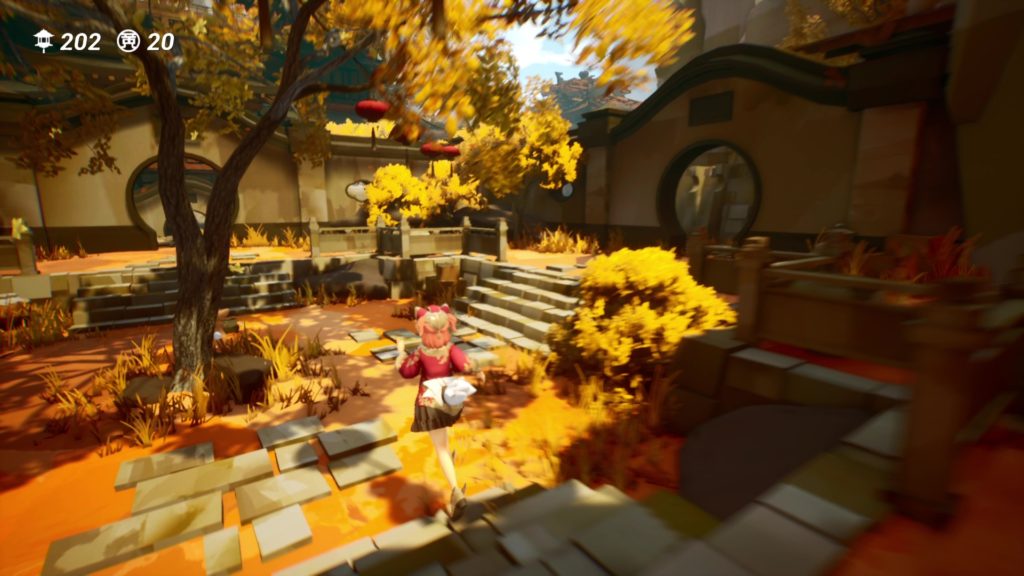
In Tasomachi: Behind the Twilight, you take on the role of a girl named Yukumo, who loves flying around in an airship. As the game opens, her airship malfunctions and she is forced to crash land in a mysterious town that is bathed in a thick fog. Upon her arrival, she finds the town curiously deserted aside from a few cat-like creatures known as the Nezu Tribe.
She quickly learns that the key to dispelling the fog over this once beautiful city is seeking the blessings of the Sacred Trees in the shrines around town — and in order to receive that blessing, she’ll need to collect the lantern-like Sources of Earth that have been scattered to the four winds. Rather conveniently, those Sources of Earth will also help her new friends from the Nezu Tribe fix up her airship so she can be on her way, too.
That’s all the setup you get, and indeed there’s not a lot more narrative throughout Tasomachi as a whole. The game does eventually build to a climax and conclusion to provide something of a sense of structure, the emphasis here is very much on enjoying the world as a playground, initially through restoring it to its former beauty and subsequently through poking your nose into every corner of it to see what you can find. And yes, there’s a lot more to find even after you’ve “beaten” the game.
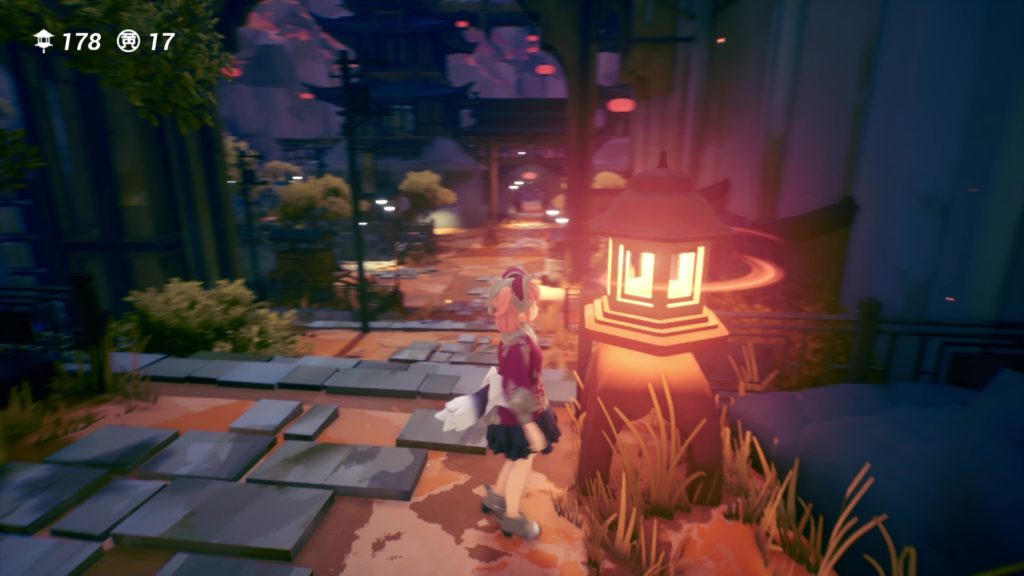
Tasomachi: Behind the Twilight is, at heart, a 3D platformer. Initially, Yukumo’s abilities are relatively limited — she can run and jump, and that’s about it. As you successfully clear the six Sacred Tree shrines in the game, however, she unlocks access to three more abilities: a “stomp” move that allows her to break through fragile floors or descend quickly; a double jump; and an in-air “boost” that propels her forwards.
The latter two in particular enhance her mobility considerably; launching Yukumo off a platform, boosting through the air and then double-jumping propels her forwards at a much greater speed than she would normally be able to attain. By mastering this technique, you can eventually make some absolutely enormous jumps that are extremely satisfying to pull off — but you’ve got to earn your “wings” before you can use them.
Tasomachi: Behind the Twilight unfolds in two main components: the open world city areas, of which there are three (plus a little “home area” that you can decorate with furnishings), and the Sacred Tree shrines, which number six. In order to access the latter, you need to uncover a certain number of Sources of Earth in the former; many of these are hidden in plain sight but require some deft platforming — and keen observation — to reach.
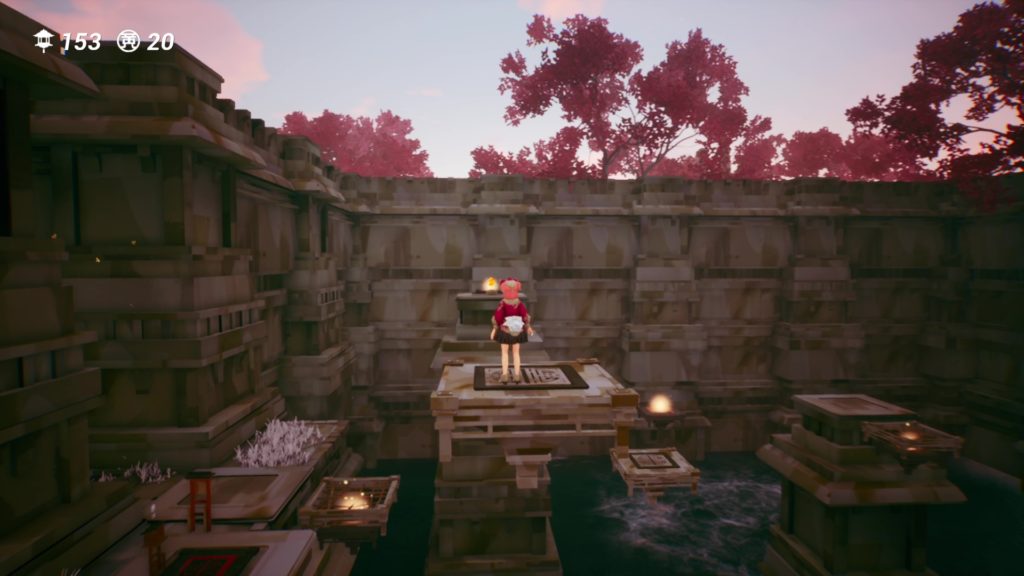
Once you’re into a Sacred Tree shrine, you’re presented with four doors, each of which houses a self-contained platforming challenge, usually focused on a specific gimmick such as jump pads, moving platforms, collapsing platforms or invisible platforms. It’s during these sequences that Tasomachi: Behind the Twilight feels at its most “gamey”, but those who want to quickly get back to the open world exploration can actually pay some of the coins you find scattered around the world in order to skip the platforming trial altogether and just gain the rewards — a nice, inclusive touch.
Don’t mistake this for being able to skip over the whole game, though. Later in the game, you’ll be able to return to each of the shrines for an additional five challenges, and there’s no skipping allowed this time around. By the time you get that deep into the game, though, you’ll have access to all of Yukumo’s abilities, and as such will have a somewhat easier time getting around.
I say “somewhat”; the platforming challenges in the Sacred Tree shrines can get pretty fiendish, particularly in their “advanced” incarnations later in the game, so be prepared for some frustration. The game works with a clear set of rules as to how its various environmental elements work, though, so succeeding at the most difficult challenges is simply a matter of observing how the world works, then making use of your own abilities to work within those constraints. Later shrine challenges see you making seemingly impossible jumps by combining Yukumo’s abilities together while timing things to match up with moving platforms — tricky, but not impossible, and enormously satisfying to get right.
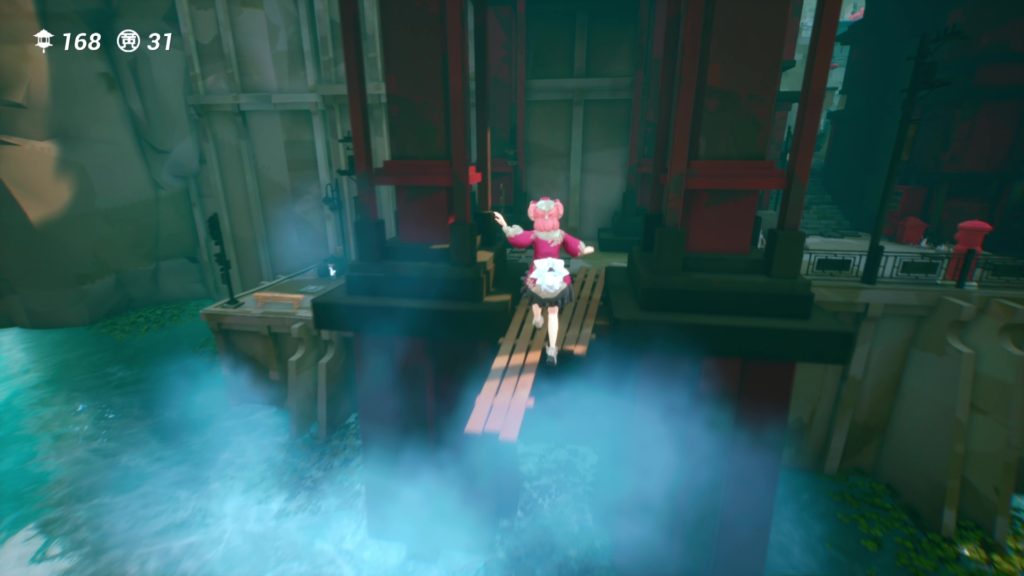
The difficulty is paced perfectly with these challenges; the early ones are very easy even for those who are relatively inexperienced with 3D platformers, but each subsequent shrine introduces one or two new elements that you’ll need to master in order to progress. In many ways, it’s clear that Tasomachi has learned a great deal from how 3D Super Mario games have been designed over the years — particularly in how Nintendo has a tendency to teach you how to play completely wordlessly, instead inviting you to play and learn through doing.
Tying in with this is the fact that Tasomachi: Behind the Twilight is completely non-violent. There are no enemies in the game, so the only risk Yukumo faces is falling into the water, as she apparently can’t swim. The only punishment for meeting a watery fate is being reset to the start of the area you’re in; there are no lives, no penalties or anything like that, so you can safely experiment and explore the world and the game mechanics, safe in the knowledge that the worst that will happen is a mild inconvenience.
The difficulty curve isn’t the only inspiration Tasomachi: Behind the Twilight has taken from the Super Mario games, either. When out in the open world city segments — which form the majority of the game’s latter half and postgame — you’ll find that pretty much everything you choose to do will end up rewarded somehow, whether it’s simply with a Source of Earth, or perhaps with some lore documents or viewpoints. The game consistently encourages the player to ask themselves “I wonder if…” and then wordlessly gives the inquisitive a virtual pat on the back for trying things. This is exactly how Super Mario Odyssey handles its collectible Moons, and it’s a beautiful way to handle a game like this.
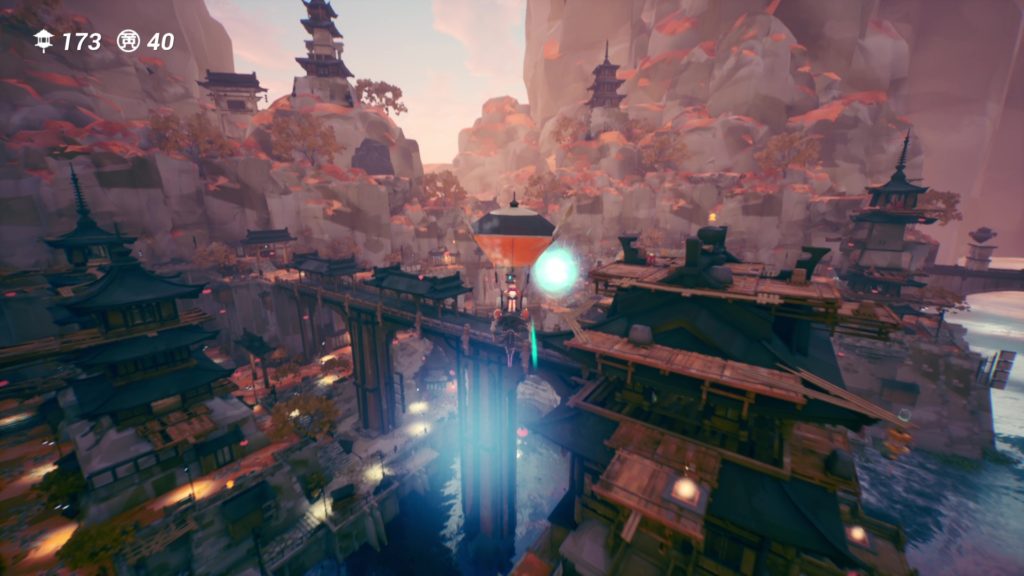
Even better, the further you go in the game, the more varied things you’re encouraged to do in the city areas. More Nezu Tribe characters will appear with tasks for you — usually involving hunting down items in the nearby vicinity — and mysterious glowing orbs will appear, challenging you to follow a trail to yet another Source of Earth. And, of course, once Yukumo repairs her airship, you can use it to fly around each of the three areas, too, with a number of airship-specific challenges scattered around the place, including following trails of checkpoints, collecting airborne items that would be impossible to reach on foot, and eventually using fireworks to blast open fragile rocks and reveal treasures within.
When you first start playing Tasomachi: Behind the Twilight, it will feel like you’re progressing alarmingly quickly, and that the whole thing will probably be over in a couple of hours. This wouldn’t necessarily be a bad thing if it was true, but the joyful thing is that the game just keeps revealing more layers the further you go, with more and more Sources of Earth just waiting to reward you for thorough exploration of these beautiful open worlds.
And dear Lord, they are beautiful — particularly once you lift the thick fog that blankets them in the early game. With each area clearly embodying a particular season and sporting Far Eastern-inspired architecture, they’re an absolute delight to explore from all angles, whether it’s from ground level on foot, hopping across the rooftops or seeing the big picture from the sky in Yukumo’s airship. You’ll find what might have initially seemed like an adventure that would be over in less than two hours ends up extending towards the 8-10 hour mark — a perfect length for a game like this.
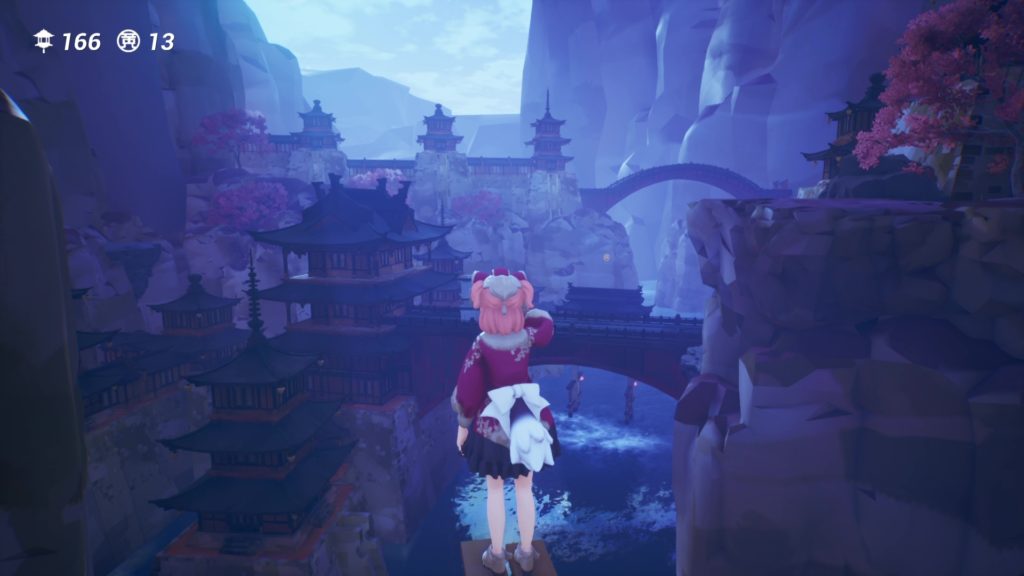
While somewhat different in tone, execution and setting I couldn’t help but find myself reminded of Keiichiro Toyama’s incredible Gravity Rush series, which likewise encouraged and rewarded exploration of every nook and cranny in its setting, particularly in its astonishingly good second installment. Tasomachi: Behind the Twilight is overall a much gentler game than Gravity Rush is, not only because it lacks combat but also in the fact that the only timed challenge in the game is one that you can’t “fail” unless you’re going for an achievement.
That said, some of those “advanced” shrine challenges will have you gnashing your teeth and flinging your controller in frustration, so this game knows that putting up a bit of a fight can be fun!
This is a game that revels in the joy of exploration, and the marvellous wonder that is having the opportunity to step into another world and see what it has to offer. It doesn’t matter that there’s hardly anyone to talk to, no strings of sidequests and a very light sense of narrative; it’s not about that. This is all about being presented with some absolutely beautiful playgrounds, being invited to roam around them as you see fit and getting rewarded for doing so. And I adore it.
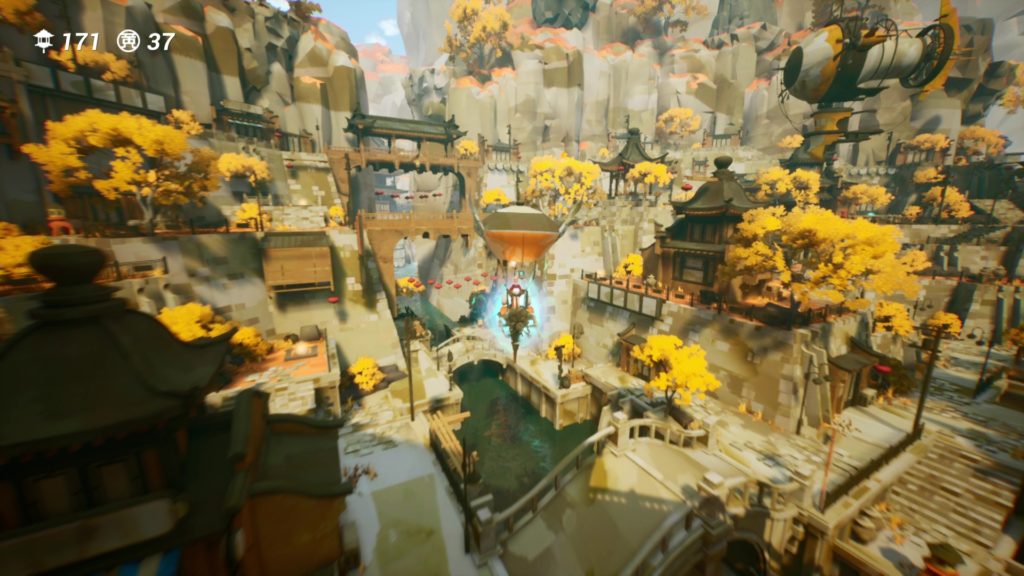
Tasomachi: Behind the Twilight is an absolute triumph, showing that open world games don’t have to be bloated messes more concerned with “player retention” than actually providing an enjoyable, compelling experience. It keeps things deliberately simple from a mechanical and narrative perspective, but provides more than enough substance to keep you coming back for more — plus a few stiff challenges for those brave enough to take them on.
This is the sort of experience open-world games should be aspiring to provide: not endless checklists of pointless busywork, but incentives for players to explore these intricately crafted environments. You should come away from an open-world experience at the very least feeling like you know your way around — and in more picturesque examples, having a strong desire to visit those places if only they were real.
That’s exactly how I feel about Tasomachi: Behind the Twilight. My time with the game has felt like a holiday to a beautiful, idyllic location with no pesky other humans to interrupt or disturb me. And heaven knows I suspect we all need a holiday right now.
Tasomachi is available now on Steam and GOG.com. Fingers crossed for a console release at some point!
Join The Discussion
Rice Digital Discord
Rice Digital Twitter
Rice Digital Facebook
Or write us a letter for the Rice Digital Friday Letters Page by clicking here!
Disclosure: Some links in this article may be affiliate links, which means we may earn a small commission if you make a purchase after clicking on them. This is at no additional cost to you and helps support Rice Digital!
- Letter from the Editor: passing the torch - June 30, 2023
- Super Woden GP 2 is looking promising - June 30, 2023
- Inti Creates is making a 32 bit-style Love Live action platformer - June 26, 2023






